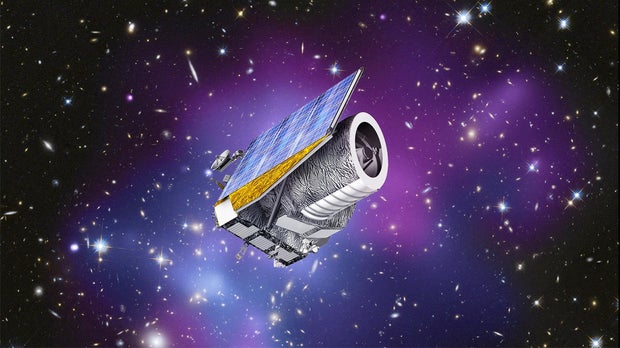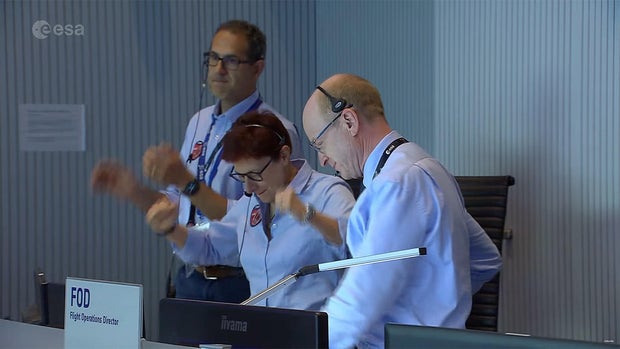European “dark energy telescope” launched to probe cosmology’s biggest mysteries
SpaceX launched the European Space Agency’s $1.5 billion Euclid space telescope Saturday, an ambitious, first-of-a-kind attempt to pin down the nature of dark matter — an unknown material pervading the cosmos — and dark energy, the mysterious repulsive force that is speeding up the expansion of the universe.
“It’s very difficult to find a black cat in a dark room, especially if there is no cat,” said Henk Hoekstra, an astronomer at the University of Leiden and a Euclid science coordinator. “That’s a little bit the situation we find ourselves in because we have these observations but we lack a good theory.
“So far, nobody has come up with a good explanation for dark matter, dark energy and other challenges also related to particle physics. … The launch of Euclid really (carries) cosmology into the future. It’s the first space mission designed to study dark energy.”
SpaceX
In 1998, astronomers mapping the expansion of the universe expected to see it slowing down due to the gravity of all its constituents. They were astonished to discover the expansion of space and everything in it began speeding up 5 to 6 billion years ago. The unknown force powering that acceleration was dubbed dark energy.
Researchers have since concluded dark energy accounts for nearly three quarters of the mass-energy budget of the entire universe. Dark matter makes up about 24% of the universe, while the atoms and molecules making up normal matter — Earth, human beings, stars and galaxies — account for just 5%.
By studying subtle changes in the light from galaxies over the past 10 billion years, Euclid’s cameras will help scientists find out if dark energy is consistent with an unchanging “cosmological constant” once predicted by Einstein’s theory of general relativity or whether the current understanding of gravity needs revision.
William Harwood/CBS News
Yannick Mellier, an astronomer at the Institut d’Astrophysique de Paris and a member of the Euclid science team, said it this way:
“The objective of the Euclid mission is to provide answers to the following questions: why is expansion of the universe accelerating, which translates into what is the nature of dark energy? Is it a cosmological constant? Is it a dynamical dark energy with properties that may vary with time? Or it is a deviation to general relativity on cosmological scales?”
At the same time, Euclid also will study the nature of dark matter, a sea of particles that do not emit or reflect light or any other electromagnetic radiation but whose gravitational effects are clearly seen. Dark matter keeps galaxies from flying apart and influences how galaxies have evolved and clustered over the 13.7 billion years since the big bang.
“Euclid will probe the distribution of dark matter and the distribution of galaxies to an unprecedented precision from space,” Mellier said. “It will also reconstruct the cosmic history of the universe over the last 10 billion years.”
It will do that by imaging more than 10 billion galaxies. Software on the ground will help identify 1.5 billion or more of the best candidates and analyze how their shapes have been distorted by clouds of unseen dark matter filling the space between Euclid and its targets.
ESA
The technique, known as weak gravitational lensing, is similar in concept to the way water slightly distorts the shapes of rocks strewn across a stream bed. It is an extremely subtle effect cosmologically, requiring complex software, powerful computers and more than 1,500 scientists at nine research centers to unravel.
But if all goes well, Euclid “will directly observe the distribution of dark matter using the gravitational lensing effect that modifies the shapes of galaxies, which are deflected by all the dark matter distribution along a given line of sight,” Mellier said. “And that will provide the distribution of the unseen dark matter in a Euclid field.”
Spectroscopic observations of tens of millions of galaxies will allow researchers to map out distances and velocities in three dimensions, shedding light on whether dark energy is, in fact, the force behind the acceleration of the cosmic expansion or whether some other explanation might be needed.
The mission began 11:12 a.m. EDT Saturday when a SpaceX Falcon 9 rocket roared to life at the Cape Canaveral Space Force Station. After a lightning-fast round of computer checks, the rocket was released to climb away atop 1.7 million pounds of thrust, putting on a spectacular weekend sky show for area residents and tourists.
Forty-one minutes later, after two firings of the rocket’s second stage engine, Euclid was released to fly on its own. The Falcon 9’s first stage, as usual for SpaceX, flew itself to landing on an off-shore droneship.
The European Space Agency, or ESA, had been gearing up to launch the Euclid space telescope last year on a Russian Soyuz rocket taking off from Kourou, French Guiana. But in the wake of Russia’s invasion of Ukraine, those plans fell apart, leaving Euclid without a ride to space.
Last July, ESA approached SpaceX about possibly launching on the company’s Falcon 9 rocket. By the end of the year, contracts were in place and the team was able to proceed to Saturday’s launch.
“We owe … huge thanks to SpaceX,” said Mike Healy, head of science projects at ESA. “Without them, our satellite would be sitting on the ground for two years.”
ESA
Euclid is bound for a region in space roughly a million miles from Earth — Lagrange Point 2 — where the gravity of sun and Earth combine to form a quiescent region where spacecraft can remain in place with minimal maneuvering and fuel usage. The James Webb Space Telescope also operates at the L2 point.
The 4,760-pound Euclid is equipped with a near-perfect 3-feet 11-inch-wide primary mirror and two instruments: a 600 megapixel visible light camera and a 64-megapixel infrared imaging spectrometer. The telescope’s field of view is roughly twice the size of the full moon.
After a month-long checkout and calibration period, Euclid will begin mapping 15,000 square degrees of sky, which includes all the space outside the Milky Way galaxy, imaging galaxies and clusters of galaxies dating back 10 billion years.
That will capture the transition from the universe’s initial gravity-driven deceleration to the era of accelerated expansion under the emerging dominance of dark energy.
“Euclid can, in one go, offer a field much larger than accessible by Hubble,” said René Laureijs, ESA’s Euclid project scientist. “During its entire lifetime, Hubble did not cover more than 100 square degrees, and this can be done by Euclid in 10 days. So in order to get our 15,000 square degrees, which is the size of our sky survey, we need these big images of the sky.”
It will take Euclid six years to complete its map of the sky, generating on the order of 100 gigabytes of compressed data per day, or an estimated, difficult-to-imagine 70,000 terabytes over the course of the mission.
“Your iPhone has maybe 10 megapixels,” said Jason Rhodes, a member of the Euclid Consortium of researchers. “So (the two Euclid) cameras together have close to 700 megapixels. We’re going to take images with those cameras every few minutes for six years.
“But the amount of data we send down compared to the amount of data that’s totally in the archive at the end of the process, that’s another factor of a thousand.”
Gaitee Hussain, head of the science division at ESA, said those images will include 8 billion galaxies, “from which the best one-and-a-half to 2 billion galaxies will be selected for the weak lensing experiment.”
“We will be collecting millions, tens of millions of spectroscopic redshifts, as well as literally billions of photometric redshifts, in order to understand the distances of the galaxies that we’re looking at,” she added.
“This implies massive data rates, not only to get the data to the ground, but also in terms of delivering data … This is what is required in order to answer what is arguably the most fundamental question in physics and cosmology today, which is, what is the universe actually made of?”
For all the latest Automobiles News Click Here
For the latest news and updates, follow us on Google News.






